Types of brick ovens for the home: types of units according to purpose and design features
A wood stove in a country house or in a country cottage can be a more than useful purchase. It is completely autonomous from external networks. Where electricity is often cut off, and a centralized gas supply has not yet been realized, they use wood to cook and they heat the house.
If a decision is made to provide housing with such a useful device, it will not hurt to study the types of brick stoves for the house in order to choose the most convenient, efficient and practical option.
We offer to deal with the traditional device of the furnace, design and operational features of various heating and cooking units, as well as find out the methods and specifics of arranging a smoke circulation system.
The content of the article:
Structural components of furnaces
Any brick oven consists of the main elements:
- foundation - the foundation on which a brick assembly weighs several tons;
- array - part of the stove, including cooking and furnace chambers, a system of smoke channels - chimney sweeps, blowing with a grate;
- chimney - chimney, towering above the stove.
The foundation for such a bulky and heavy construction is arranged separately from the main foundation of the house.
If there is a tape or columnar base under the building, you need to make sure that it does not come into contact with the foundation of the stove. This will avoid the appearance of deformations from an unevenly distributed load, because under the brick aggregate it will be much higher.
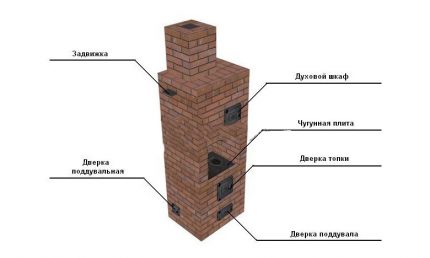
A monolithic foundation in private homes, especially small ones, is rare. If there is one, the oven can be installed directly on it. It is best to include the construction of such an object in the overall project in advance.When the house is ready, you should coordinate the appearance of such an additional load with an experienced engineer.
The base of the furnace separates the furnace or gas chamber from the foundation. These are several rows of continuous brickwork, which are heated and give part of the heat to the room, and also protect the base from overheating.
Over the base do what is called a firebox. Below, under the combustion chamber, a small cavity is arranged - it is blown out. A furnace is located above it, in which fuel is burned. A grate made of durable cast iron separates the blower and the firebox.
Firewood is laid directly on this grate. Through the blower and the grill, the air necessary for combustion enters the fuel. At the same time, the necessary draft is created for the removal of flue gases through the flue system. But its design depends on what type of brick oven for the house was chosen.
The device can also be supplemented with elements such as a hob and an oven. There are options for furnaces with drying chambers and even with warm stove benches. Understanding the principles of the device and the operation of such a structure will help to choose the right type of stove, as well as solve issues related to its construction.
Different functionality
First you need to decide on the functions that the device will perform.
It could be a stove:
- for cooking only;
- exclusively for home heating;
- to perform both of these functions, i.e. combined option.
Cooking stove most often put in small freestanding kitchens. The heat of burning firewood is more than enough not only for cooking, but also for heating such a room.

Therefore, the device is placed next to two external walls, so that excess thermal energy moves to the street. The chimney in this case is arranged strictly vertical, small in size.
Heating stove. The design provides for the maximum retention of thermal energy within the house. Such a device has neither a stove nor an oven, but the furnace array is equipped with an extensive smoke exhaust system.
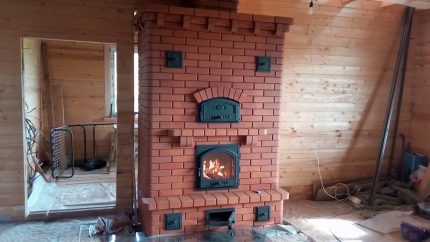
A bulky chimney is necessary so that the combustion products do not leave the house too quickly and have time to heat the brickwork, which then gives off heat to the indoor air. Such a stove is placed as close to the center of the house as possible so that the heating of individual rooms is uniform.
Detailed information about the device for stove heating in a private house is presented in this article.

Combined Oven. For its device, they use both a hob and a branched chimney. They put it in the kitchen, but not near the outer walls, but next to the inner ones. If possible, the chimney is also shifted towards living rooms in order to provide them with a sufficient amount of heat.
Types of heating stoves
Story wood stove counts centuries, if not millennia. In different countries, the best models have gained well-deserved distribution.
Such designs are used today, both in a classic form, and with some additions.
Russian stove: complex and efficient
A traditional Russian stove is a large universal device. Although there is no cast-iron hob here, you can cook in it. The massive case perfectly warms the room, and in the upper part there are patches - a warm couch.
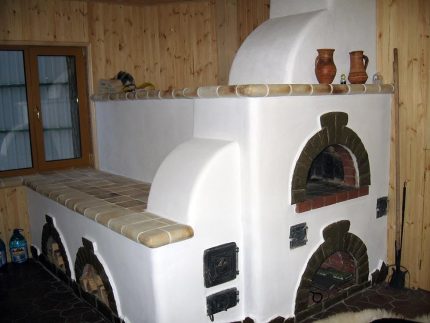
The long firebox is divided into two zones: a bakery located in the front part, and a firebox, where wood is burned. Such a furnace works in two modes. At first it is heated for some time. During this period, the device accumulates heat. After that, for about a day, the melted furnace is heated, slowly giving off thermal energy.
During this period, you can cook various dishes in the bakery with the unique taste that no other cooking unit can give them. The characteristics of the Russian stove are due to the special nature of the movement of air flows inside the device.

In front of the fuel chamber there is a so-called swirl, the area above it is called an overtube, and even tapering the top is a hail.
Thanks to such a device, a recuperation zone is formed in the blower, where the smoke leaving the furnace heats the oncoming fresh air stream. In this case, the flows do not mix, oxygen enters the furnace in full.
Unusually, the fuel chamber device. The bottom of the firebox is uneven, it is laid out with a rise relative to the cooking chamber. The upper arch is also not horizontal, it is higher in the back, falls closer to the mouth and ends with a nut.
Between the base Russian stove and its fuel chamber makes a long cavity called a guardianship. It is always warm here, it is often used to store firewood. In such conditions, the fuel dries well, it flares up faster and better gives off heat.
On our site there is a block of articles devoted to the independent construction of different models of the Russian stove, we recommend that you read:
- Russian stove with stove: masonry technology of the Russian stove with diagrams and detailed procedures
- Do-it-yourself mini Russian stove: specifics and arrangements for the construction of a compact stove
- DIY do-it-yourself stoves: construction manuals with diagrams and procedures
"Dutch" - a simple heating unit
The Dutch stove was originally created for heating. It differs from traditional Russian in a simpler and easily modernizing design. The device and dimensions can vary depending on the situation, for example, on the size of the house.
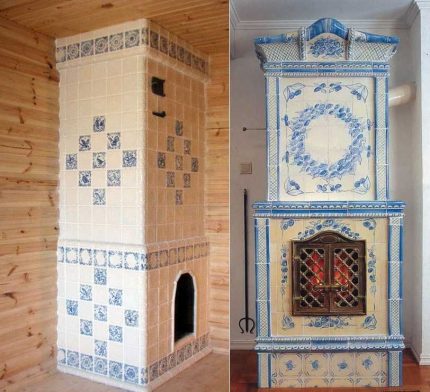
At the bottom there is a combustion chamber, at the top there is an extensive network of chimney sweeps, including several vertical channels interconnected by horizontal jumpers. As a result, the path along which the smoke travels is lengthened, and the heat remains in the house.

In modern versions, the Dutchwoman is also supplemented with a hob, but initially the hearth was set separately for these purposes.
Inexperienced stoves are recommended to start practicing on this type of stove, since it is quite difficult to spoil it.
Swedish oven: an interesting combination option
Another interesting option for a novice master is the “Swedish” oven. Its design was developed by Swedish scientists not so long ago, in the middle of the XVIII century. They took the Dutch as a basis and greatly improved it.
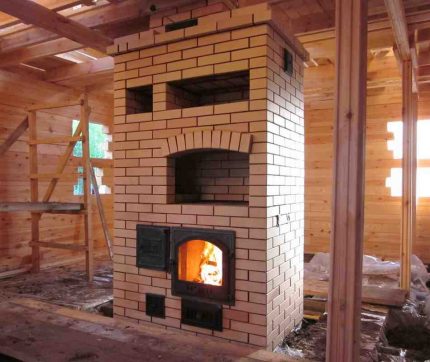
The lower part of such a stove is wider; below, in addition to the combustion chamber, there is an oven installed on the side. As a result, the first heat from the combustion of fuel does not go through the chimney channel, but works to heat the oven. If you open it, heat will warm the floor and rise up.
The firebox itself is a variant of a simplified hood; here, both primary combustion of fuel and chemical secondary afterburning take place. A niche is made in the upper part of the structure, which has traditionally been used to dry wet clothes for a day of clothing.

An oven installed on the side of the firebox quickly accumulates primary heat. The cabinet above the stove was used to store food prepared in the evening, by morning it remained warm and quickly warmed up in the oven.
The vertical system of smoke circuits warms the house well, but when the view is open, the heat quickly disappears, you just need to remember to cover it after the firebox.
They heat such an oven twice a day. The efficiency of the “Swede” is almost as high as that of the Russian stove, while it is easier to fold, cheaper, and it takes up less space. But high efficiency is achieved due to accurate calculation, so during masonry you will have to strictly observe the dimensions and proportions.
Chimney versions of brick kilns
The efficiency of a wood-burning stove largely depends on the type of its chimney. Properly organized movement of flue gases allows you to save heat and effectively remove the products of combustion of fuel without danger to the health of residents.
Such a design may be:
- with horizontal channels;
- with vertical channels;
- combined.
In the direction of movement of flue gases, stoves with smoke circuits are divided into direct-flow and counter-current. In the second embodiment, the smoke, before flying into the chimney, makes several revolutions inside one of the smoke chambers. He moves at this time in two different directions.
Horizontal channel system It is used infrequently. It warms the oven evenly, but for each horizontal level you will have to make a clean door. A modification of this chimney can be an option with pockets. These cavities will hold the smoke for a while and increase the efficiency of the stove.
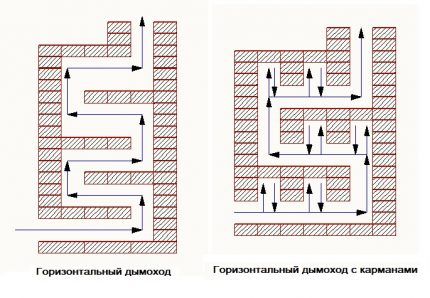
Vertical channel. The principle of operation of such a chimney has been described above as a characteristic feature of the Dutch oven. In such a system, soot accumulates less, it is easier to clean.
But here the resistance to the movement of the smoke stream increases, so it is necessary to make such a chimney long enough to provide normal draft. In the vertical version, the first channel warms up more than the others.
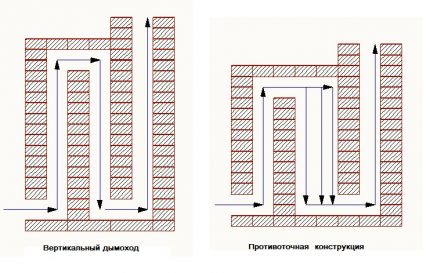
Such a temperature difference can cause masonry damage. To improve the situation, it is possible to arrange a transfer version in which the middle channel is made much wider than the extreme ones. The cross section here will be larger, this will slow down the flow rate and make heating more uniform.
Bell furnace - An alternative to design with vertical and horizontal fumes. Instead of channels, there is a spacious cavity in which smoke accumulates, and after cooling it moves down and leaves through the chimney. Even after complete combustion of the fuel, the gases in the hood continue to give off heat.

Unlike a vertical smoke circulation system, there is no danger of quick blowing of gases and cooling of the furnace. Cap sizes and configurations may vary.
When designing a furnace, you can combine caps with elements of a vertical chimney to obtain an efficient design and increase efficiency.
Conclusions and useful video on the topic
Traditional Russian stove:
Swedish heating stove:
A little "Dutch":
Brick stoves are very diverse, you can always pick up or design an option that is suitable for specific conditions. A common requirement for all models is accurate calculation, the use of high-quality materials and competent operation.
Have something to supplement, or have questions about choosing a brick oven for the home? You can leave comments on the publication, participate in discussions and share your own experience in using stove heating. The contact form is located in the lower block.

 Brick stove for the home: guidelines for choosing the optimal type and examples of routines for independent masters
Brick stove for the home: guidelines for choosing the optimal type and examples of routines for independent masters 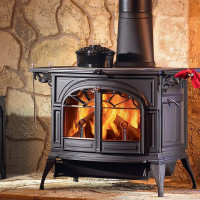 Wood stoves for heating a private house: rating of popular models + benchmarks for the buyer
Wood stoves for heating a private house: rating of popular models + benchmarks for the buyer  Heat-resistant paints for stoves and fireplaces: an overview of popular heat-resistant compounds
Heat-resistant paints for stoves and fireplaces: an overview of popular heat-resistant compounds 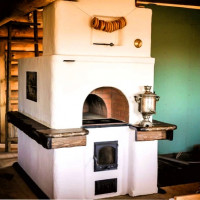 How the Russian stove works: design features and an overview of popular types of Russian stoves
How the Russian stove works: design features and an overview of popular types of Russian stoves 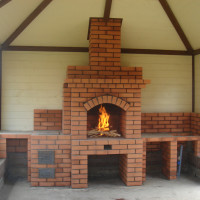 Brick stoves for giving on wood: the best orders and a step-by-step guide to the construction
Brick stoves for giving on wood: the best orders and a step-by-step guide to the construction 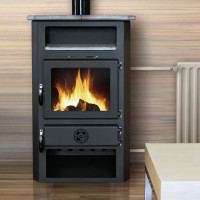 A furnace with a water circuit for heating a house: features of furnace heating + selection of the best option
A furnace with a water circuit for heating a house: features of furnace heating + selection of the best option  How much does it cost to connect gas to a private house: the price of organizing gas supply
How much does it cost to connect gas to a private house: the price of organizing gas supply  The best washing machines with dryer: model rating and customer tips
The best washing machines with dryer: model rating and customer tips  What is the color temperature of light and the nuances of choosing the temperature of the lamps to suit your needs
What is the color temperature of light and the nuances of choosing the temperature of the lamps to suit your needs  Replacement of a geyser in an apartment: replacement paperwork + basic norms and requirements
Replacement of a geyser in an apartment: replacement paperwork + basic norms and requirements
We have a Dutchwoman in our house. With ever-increasing gas prices, this is a good option. Kommunalka used to eat half of the family budget. We have already seen that it is much more economical. But we did not decorate it with tiles. Painted with a simple water-dispersion paint. When a furnace is drowned, no smell arises, and even surface irregularities are not so noticeable to the eye.
It has long been a desire, or perhaps even a dream, to make a real Russian stove with a stove bench in the country, where you can relax, almost like Ilya Muromets. Only a decent price for its laying stops. And to do it yourself, perhaps, is also beyond the power. And so I don’t see any minuses at all, sheer pluses. And heats well and for a long time, and you can cook. No wonder our ancestors did such things.
Like it or not, but the Russian stove also has disadvantages. First of all, it takes up a lot of space and is demanding on the foundation. For good, the foundation for the stove needs to be laid together with the foundation of the house. Plus she needs a lot of firewood, not the most efficient stove. Well, we don’t forget about whitewashing every year.
In the horizontal (clerical?) Version, the first channel warms up more than the others.
Yes, thanks, corrected.